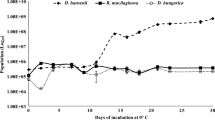Abstract
As an eco-friendly management method, biological control of postharvest diseases, utilizing antagonistic yeasts, is a research topic receiving considerable attention. Detailed knowledge on the biology of yeast antagonists is crucial when considering their potential application and development as biocontrol products. Changes in the growth form, such as single-cell to pseudohyphae, have been associated with the mode of action in postharvest biocontrol yeasts. In this study, the antagonistic yeast, Candida diversa, reversibly shifted from a single-cell morphology on yeast peptone dextrose (YPD) medium with 2 % agar to a pseudohyphal morphology on YPD with 0.3 % agar. The tolerance of the pseudohyphal form to heat and oxidative stresses, as well as the biocontrol efficacy against Botrytis cinerea on apple and kiwifruit stored at 25 and 4 °C, was significantly higher as compared to the single-cell form. This study provides new information on the ability of C. diversa to change its morphology and the impact of the morphology shift on stress tolerance and biocontrol performance.


Similar content being viewed by others
References
Chi M, Li G, Liu Y, Liu G, Li M, Zhang X, Sun Z, Sui Y, Liu J (2015) Increase in antioxidant enzyme activity, stress tolerance and biocontrol efficacy of Pichia kudriavzevii with the transition from a yeast-like to biofilm morphology. Biol Control 90:113–119
Droby S, Wisniewski M, Macarisin D, Wilson C (2009) Twenty years of postharvest biocontrol research: is it time for a new paradigm? Postharvest Biol Technol 52:137–145
Fiori S, Scherm B, Liu J, Farrell R, Mannazzu I, Budroni M, Maserti BE, Wisniewski ME, Migheli Q (2012) Identification of differentially expressed genes associated with changes in the morphology of Pichia fermentans on apple and peach fruit. FEMS Yeast Res 12:785–795
Giobbe S, Marceddu S, Scherm B, Zara G, Mazzarello VL, Budroni M, Migheli Q (2007) The strange case of a biofilm-forming strain of Pichia fermentans, which controls Monilinia brown rot on apple but is pathogenic on peach fruit. FEMS Yeast Res 7:1389–1398
Kumamoto CA (2005) A contact-activated kinase signals Candida albicans invasive growth and biofilm development. Proc Natl Acad Sci U S A 102:5576–5581
Lahlali R, Jijakli MH (2009) Enhancement of the biocontrol agent Candida oleophila (strain O) survival and control efficiency under extreme conditions of water activity and relative humidity. Biol Control 51:403–408
Leaw SN, Chang HC, Sun HF, Barton R, Bouchara JP, Chang TC (2006) Identification of medically important yeast species by sequence analysis of the internal transcribed spacer regions. J Clin Microbiol 44:693–699
Li Z, Chen Y, Liu D, Zhao N, Cheng H, Ren H, Guo T, Niu H, Zhuang W, Wu J, Ying H (2015) Involvement of glycolysis/gluconeogenesis and signaling regulatory pathways in Saccharomyces cerevisiae biofilms during fermentation. Front Microbiol 6:139
Liu J, Sui Y, Wisniewski M, Droby S, Liu Y (2013) Review: utilization of antagonistic yeasts to manage postharvest fungal diseases of fruit. Int J Food Microbiol 167:153–160
Mari M, Di Francesco A, Bertolini P (2014) Control of fruit postharvest diseases: old issues and innovative approaches. Stewart Postharvest Rev 10:1–4
Maserti B, Podda A, Giorgetti L, Del Carratore R, Chevret D, Migheli Q (2015) Proteome changes during yeast-like and pseudohyphal growth in the biofilm forming yeast Pichia fermentans. Amino Acids 47:1091–1106
Pu L, **gfan F, Kai C, Chao-an L, Yunjiang C (2014) Phenylethanol promotes adhesion and biofilm formation of the antagonistic yeast Kloeckera apiculata for the control of blue mold on citrus. FEMS Yeast Res 14:536–546
Raspor P, Miklič-Milek D, Avbelj M, Čadež N (2010) Biocontrol of grey mould disease on grape caused by Botrytis cinerea with autochthonous wine yeasts. Food Technol Biotechnol 48:336–343
Sanna ML, Zara G, Zara S, Migheli Q, Budroni M, Mannazzu I (2014) A putative phospholipase C is involved in Pichia fermentans dimorphic transition. Biochim Biophys Acta 1840:344–349
Scherm B, Ortu G, Muzzu A, Budroni M, Arras G, Migheli Q (2003) Biocontrol activity of antagonistic yeasts against Penicillium expansum on apple. J Plant Pathol 85:1–9
Sui Y, Wisniewski M, Droby S, Liu J (2015) Responses of yeast biocontrol agents to environmental stress. Appl Environ Microbiol 81:2968–2975
Teixidó N, Viñas I, Usall J, Magan N (1998) Improving ecological fitness and environmental stress tolerance of the biocontrol yeast Candida sake by manipulation of intracellular sugar alcohol and sugar content. Mycol Res 102:1409–1417
Thompson DS, Carlisle PL, Kadosh D (2011) Coevolution of morphology and virulence in Candida species. Eukaryot Cell 10:1173–1182
Vero S, Garmendia G, González MB, Bentancur O, Wisniewski M (2013) Evaluation of yeasts obtained from Antarctic soil samples as biocontrol agents for the management of postharvest diseases of apple (Malus x domestica). FEMS Yeast Res 13:189–199
Wilson CL, Wisniewski ME (1989) Biological control of postharvest diseases of fruits and vegetables: an emerging technology. Annu Rev Phytopathol 27:425–441
Acknowledgements
This work was supported by the National Natural Science Foundation of China (Nos. 31401794, 31101480 and 31171893), Provincial Natural Science Research Project of Anhui Colleges (No. KJ2014ZD25), a China Postdoctoral Science Foundation Funded Project (No. 2015 M570534), Public Service Platform in Anhui Wanjiang Institute of Poultry Technology (No. 1401032006), and the Project Sponsored by the Scientific Research Foundation for the Returned Overseas Chinese Scholars, State Education Ministry to Yuan Sui.
Author information
Authors and Affiliations
Corresponding authors
Ethics declarations
This article does not contain any studies with human participants or animals.
Conflict of interest
The authors declare that they have no competing interests.
Additional information
Responsible editor: Philippe Garrigues
Guangkun Li, Mengshan Chi, Huizhen Chen and Yuan Sui contributed equally to this work.
Rights and permissions
About this article
Cite this article
Li, G., Chi, M., Chen, H. et al. Stress tolerance and biocontrol performance of the yeast antagonist, Candida diversa, change with morphology transition. Environ Sci Pollut Res 23, 2962–2967 (2016). https://doi.org/10.1007/s11356-015-5769-8
Received:
Accepted:
Published:
Issue Date:
DOI: https://doi.org/10.1007/s11356-015-5769-8




